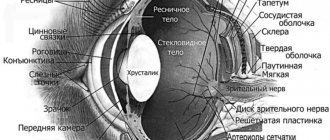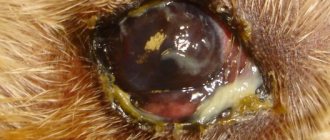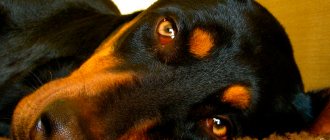It's no secret that animals feel and see the world differently than people. At the same time, in order to better understand your pet and create more effective training programs, it is important for the owner to imagine how dogs see, how they hear, what they respond best to, etc. After all, for example, what colors dogs recognize determine what shades the shells and retrieval items should be. Given the importance of these issues, we decided to publish a series of articles devoted to the sense organs of animals. In this material, we talk about what kind of vision dogs have, and we will talk about hearing and smell in subsequent publications.
Interesting anatomy: the structure of the eye and the “visual” areas of the brain
The dog eye consists of the cornea, iris, pupil, lens and retina. The very first layer performs a protective function, and the very last is responsible for transmitting images to the brain. The final picture is formed by the visual cortex, located in both hemispheres of the brain. It is concentrated in the occipital lobe.
Light waves refracted by the lens enter the retina, which consists of many photoreceptors: cones and rods. The former determine the color in which dogs see the world, and the latter are responsible for the acuity of night vision.
What colors do dogs see?
It has long been assumed that dogs see the world in black and white. Actually this is not true. The color spectrum they distinguish is much wider, but still inferior to that detected by humans. The small number of cones is to blame for this.
Our pets do not perceive the red and green color spectrum, but they can clearly distinguish blue-violet and as many as 40 shades of gray. The tapetum, a reflective membrane located directly behind the retina, is responsible for this.
In terms of their vision, animals resemble colorblind people. Despite this, they easily cope with the work of a guide and accurately transfer blind people to the desired traffic light. The thing is that four-legged helpers pay attention to the location of the signal and its brightness, and not to a specific shade.
Why is it so important for dog owners to know about their pets’ visual needs?
Every dog owner should know that their pet can only see specific colors. First of all, this is necessary to select the right toys for him. They should be blue or yellow, he can distinguish between them. The correct color choice of equipment will greatly facilitate and speed up the learning and training process.
Knowledge about the visual characteristics of pets will help the owner to properly concentrate their attention on himself. To do this, you need to stand directly in front of the animal, blocking its viewing angle as much as possible.
Thanks to the unique structure of their eyes, dogs have excellent vision in the dark.
Differences in perception between humans and dogs
The picture we see is significantly different from how dogs perceive the world. Among the main features of canine vision are:
- Limited color perception. Because of this, the world of our four-legged friends is 3 times less colorful and a little blurry.
- Good spatial orientation after dark. Numerous cones are responsible for this, drawing clear boundaries between different shades of gray.
- A wider binocular field angle, turning the whole world into a huge panorama.
- Farsightedness. Animals see very poorly at close range and do not have a macula responsible for visual acuity. For this reason, they focus not on the object itself, but on its movement. Thanks to this feature, pets can clearly distinguish moving objects located at a distance of 1.6 km.
- Higher speed of visual perception. Our pets do not understand what is happening on TV screens. The standard frequency (60 Hz) is too low for them to see a moving picture. The image shown on the screen is perceived by them as a chaotic flickering of static frames. Therefore, the interest in watching programs together is explained more by the sounds they catch.
In addition to the tapetum, four-legged pets have one unusual organ for us - the third eyelid. Like the cornea, it has a protective function and acts in a similar way to a horizontal windshield wiper.
How does the eye work?
The canine organ of vision is similar in structure to the human, as in all mammals. But there are some differences.
It is known that the retina consists of two types of cells. In humans, cones predominate. In the central part of our retina there is even a spot (macula macula) consisting exclusively of flask-shaped cells.
They are responsible for color perception and vision during the day. People have three types of cones, some perceive a spectrum of red and orange with long wavelengths, others - medium green and yellow tones, and others - short blue and cyan colors.
This is interesting: How to Eat Feijoa Fruit
A dog has only two types of flask-shaped cells; it does not have cells that perceive the red spectrum. There is no yellow spot either. But there are much more rods than in humans.
It is this feature that helps dogs see at night. In addition, at the bottom of the cells there are so-called mirrors that reflect light.
They are formed by a pigment called tapetum. This further improves vision in the dark. Thanks to reflection in the dark, dogs' eyes glow. The retina is divided into two parts.
The upper one perceives the sun, the lower one reflects them. During the day, this feature helps you avoid squinting even under the bright rays of the sun. The lower part contains the most rods with pigment that reflects light.
It is this feature that helps dogs see better at night. Four-legged pets can distinguish many more shades of gray than people, which also has a positive effect on their ability to look in the dark.
Night vision
A person's visual acuity is largely influenced by the macula. The dog does not have a place where the cones are concentrated. That's why it's not as spicy as ours. If he could read a sign with letters at an ophthalmologist's appointment, he would only see the first three rows.
Most dogs have mild farsightedness, approximately +0.5 diopters. But this absolutely does not prevent them from seeing well after dark. Dogs perceive moving objects better than those that stand still.
At night, acute vision does not play such a role as during the day. In the dark, the dog will calmly see moving prey at a distance of close to one kilometer.
Color perception
The visual field is the area that a person or animal sees when looking forward.
Depends greatly on the position of the eyes. Therefore, different breeds have different fields of vision. It is wider in those dogs that have an elongated muzzle, with eyes located on the sides. On average, this angle in dogs is 250° (in humans it is 180°). For a long time it was believed that dogs do not perceive colors. Scientific research shows that this is not the case.
They have many fewer cones than humans, but they still have them. The red spectrum is not available to dogs. But they perceive blue and cyan colors. In addition, dogs can distinguish many more shades of gray than humans.
This ability is provided by sticks. It also helps dogs recognize objects more clearly when night falls. We hope we have answered the question.
They are much better at navigating space at night using their vision than humans. After all, dogs contain the characteristics of universal hunters who pursue prey at any time of the day.
But besides sight, their sense of smell helps them in many ways. It is several times stronger in four-legged predators than in you and me.
Why is a dog’s vision not the main way of perceiving the world?
In fact, it is not so important for the perception of the world what kind of vision a dog has. This task is perfectly accomplished by acute hearing and a developed sense of smell, many times superior to humans.
Unlike humans, who rely 90% on their eyes, animals navigate by sounds and smells. Four-legged pets even detect ultrasound, and with the onset of darkness their sensitivity only improves. At night, they easily distinguish sounds at a distance of up to 150 m, so noise inaudible to us can cause them anxiety and seemingly causeless barking.
Despite myopia, our pets never lose a piece of food that falls out of the bowl. They just find it by smell. Up to 1 million different aromas are distinguishable for a dog's nose, but only 40 thousand for a human nose. This feature is used when searching for missing things and people, since the service dog clearly senses odors within 1 km.
In the light and in the dark
Four-legged pets are excellent hunters. Nature made sure that they saw well not only in the light, but also in the dark. Their pupil regulates the amount of light passing through, contracting and dilating in different types of lighting. Next, the rays that hit the retina are processed by one of its sectors:
- Lower
. Absorbs too bright streams, facilitating visibility even in harsh light. Thanks to this, the animals do not need sunglasses. They can calmly look at the sun with wide open eyes without squinting.
- Upper
. This sector is responsible for how dogs' vision becomes at dusk. The tapetum, located behind the retina, reflects oncoming light and acts in a similar way to car headlights. It is because of this that you can see an unusual glow in the eyes at night. The specific shade depends on the color of the iris.
The clarity of the image visible to a dog's eye under night lighting is almost 4 times higher than human capabilities. A dog that finds itself in an unfamiliar dark room will have no problem finding its way around it, avoiding collisions with chaotically placed objects.
How far and how wide can dogs see?
Due to the absence of a yellow spot, animals practically do not see objects located at a distance of up to 25 cm. But they perfectly distinguish between stationary objects within 600 m and moving ones within 900 m. This feature is determined by the hunting instinct, where it is important not to miss the fleeing prey. This is why you should not run away from an unfamiliar dog.
In addition to the dog’s range of vision, its field, that is, latitude, is also unique. While a human's viewing angle is limited to 180°, a dog's is as much as 250°. Thanks to this feature, animals see what is happening not only in front, but also on the sides, skillfully assessing the distance to objects located in the visual zone.
line of sight
Let's compare the field of vision of a human and a dog. The position of the eyes determines the width and length of the visible field. The human field of vision is 200 degrees, of which 140 are binocular. The binocular part of four-legged pets ranges from 30 to 60 degrees with a total field of view of 240 degrees. This is due to the location of the animal’s eyes on the sides of the skull. They have a wider field of vision, they can see to the sides, but not very well in front of them.
Clarity, Sharpness, Contrast
Having figured out what kind of vision dogs have, it is easy to understand that the clarity, sharpness and contrast of the image they perceive is significantly inferior to humans. For our pets, the world around us looks blurry and faded. It can be compared to a photograph of very poor quality. But there are also some peculiarities.
Picture quality improves when focusing on dynamic objects. If you freeze when confronted with an aggressive animal, you will become practically invisible to it. Although you should not completely rely on this trick, since your presence will be confirmed by a keen sense of smell.
An example is checking visual acuity using a special table. A person with perfect vision will see the first 10 lines, but his four-legged pet will only see the first 3.
What is more important for a dog – vision or smell?
People learn 90% of information through vision. For the younger brothers, everything is different. Since they cannot see close objects, especially if they are in a static position, their sense of smell saves them. This way they recognize plants, their toys and other objects. Therefore, an animal’s sense of smell is paramount for obtaining information about the surrounding world.
Note! If you play with your pet with two balls of yellow and red, he will not be able to distinguish them, because they will look identical to him in shade. And only thanks to the sense of smell the animal will be able to understand which ball is which.
Do some breeds see differently?
Despite the general similarity of visual perception, some breeds see the world a little differently. What kind of vision your dog has can be determined by the shape of its skull and nose, as well as the distance between the eyes.
Greyhounds and hounds, intended for hunting, have a greater angle of latitude than representatives of brachycephalic breeds (pugs, bulldogs, Pekingese). Despite this, flat-faced pets are no less amazing. They see the image on the TV screen and the image of their owner much more clearly. That is why such animals are more affectionate and emotional.
Vision problems
With age, visual function weakens - and this is absolutely normal, but sometimes problems appear at a very young age. For this reason, you should know exactly what kind of vision your dog has and how much it differs from the recommended norm.
In addition to a full examination at the veterinary clinic, there are several simple ways to assess eye health at home:
- Checking pupil reaction
. Move your hand in front of your pet. If he is healthy, then his pupils will move along a similar route.
- Creating an "obstacle course"
. Place various objects around the room in a chaotic order, go to the farthest corner and call your pet. A healthy dog can easily navigate the route without hitting any obstacles.
- "Cotton Ball"
. Roll small balls of cotton wool and throw them in front of the animal. His pupils must watch the fall without interruption. It is recommended to perform this exercise in pairs with an assistant who will cover one of the eyes. In this case, you can evaluate the health of each eye separately.
In most cases, ophthalmological pathologies are to blame for the deterioration of visual function. Knowing the main reasons for their appearance, you can easily maintain the health of your pet.
Why they occur and how to prevent them
Eye diseases occur due to mechanical injuries and neoplasms, as well as as a complication of allergies and infections. Violations can be prevented by strengthening the immune system and eliminating provoking factors. To do this you need:
- Monitor the quality and balance of your diet.
- Promptly trim excessively long hair on the face that irritates the cornea.
- Regularly treat your eyes with herbal infusions and protect them from drying out.
- Place all dangerous objects out of reach.
- Check the integrity and cleanliness of the space between the skin folds after each walk.
- Don't skip your annual checkup with your veterinarian. It is recommended to pay special attention to breeds with bulging eyes.
Sometimes genes are to blame for a disease. In this case, it is they who determine what kind of vision the dog will have. Congenital pathologies cannot be treated, but their development can be slowed down.
Useful tips
Let's look at some useful tips for keeping dogs that will help avoid eye problems:
- Walk your pet often to keep it healthy and strong. Sitting on the sofa negatively affects the functioning of the hormonal system, which worsens the well-being and health of the animal. However, avoid conflicts on the street to avoid mechanical eye injury.
- It is recommended to take your dog for a preventive examination 1-2 times a year. If the animal is sick, you must go to the doctor without fail. Some diseases are not dangerous, but they still need to be treated, since they can cause complications in internal organs, including the eyes.
In conclusion, we note that the quality of vision also depends on the breed. Small dogs usually have less acute vision, but age-related problems do not appear until much later. Large breed dogs are more aggressive, so they are more likely to get into conflicts with other animals, which can lead to eye injury.











